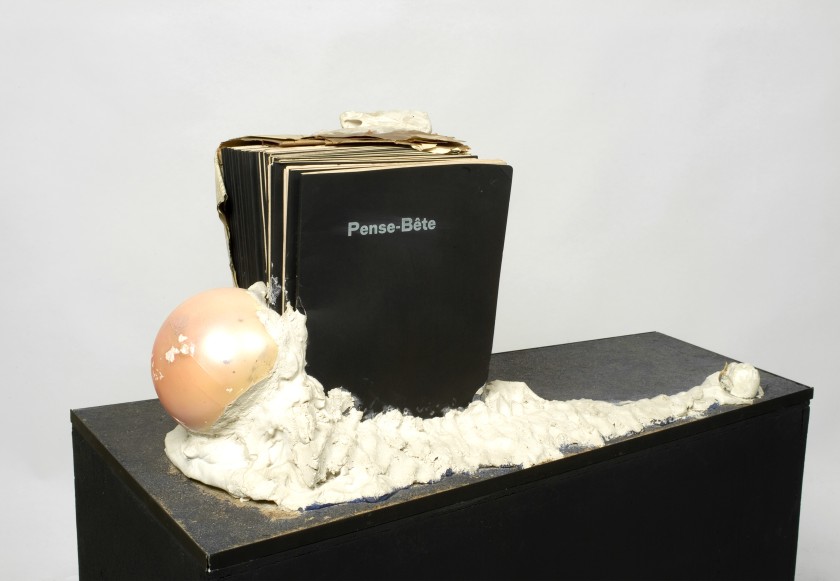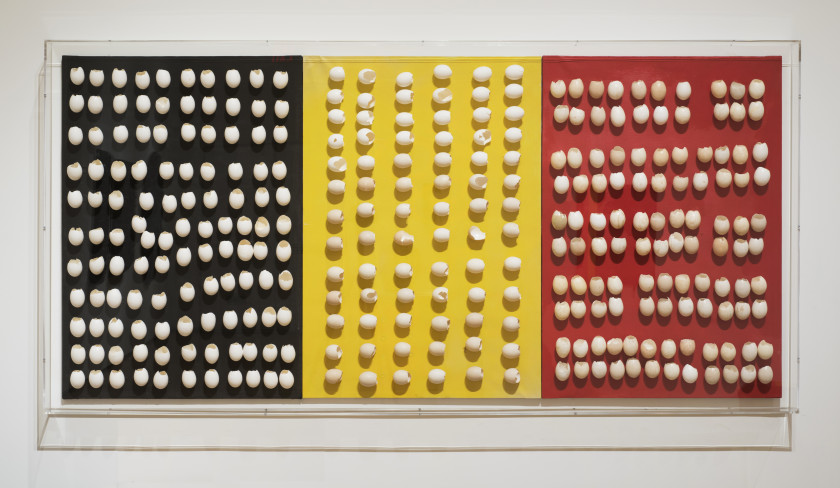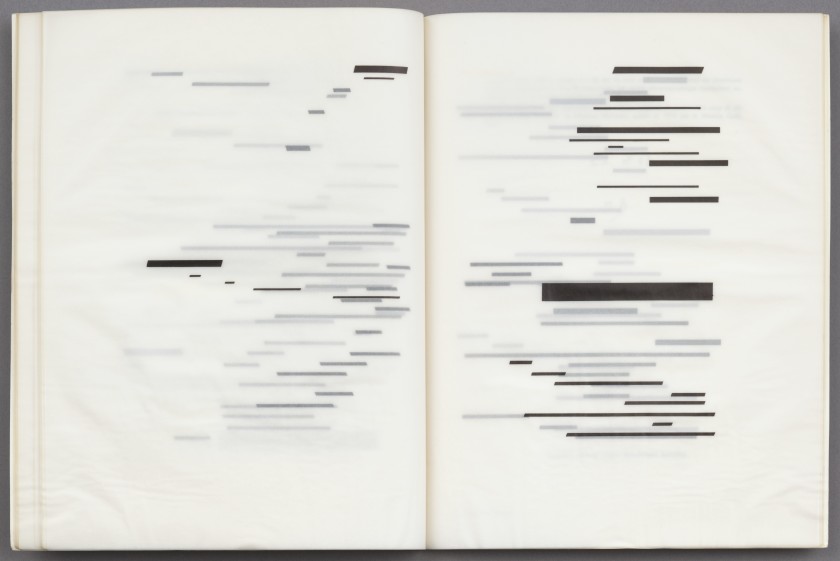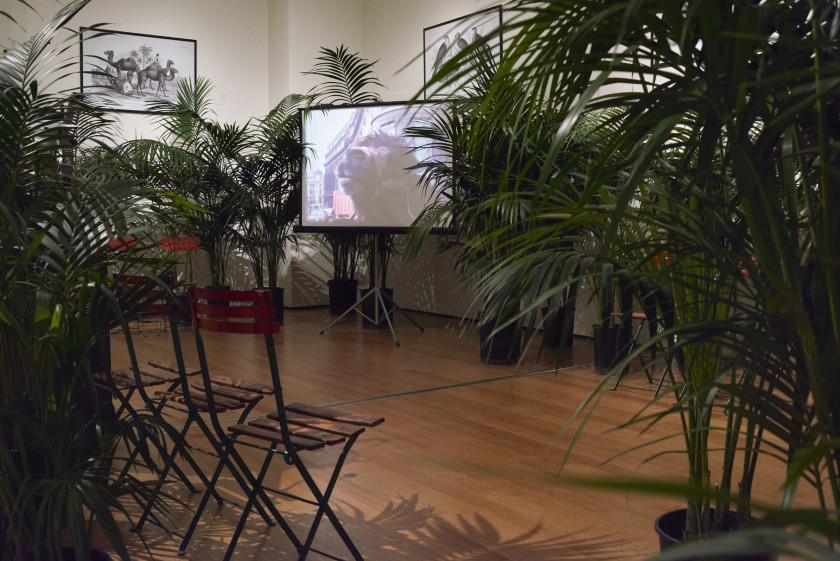Marcel Broodthaers: A Retrospective, MoMA
by Anastasia Karpova Tinari
At the 1958 Brussels World’s Fair, a mock Congolese village complete with performing Africans was installed, intending to provide Belgians a glimpse of their colony, a backward ethnographic presentation described today as a “Human Zoo.” This phenomenon came from a long tradition of installations at World’s Fairs, inaugurated in Paris in 1889 and practiced throughout the early twentieth century in Germany as Völkerschau (Peoples Show), capturing the colonized in their “primitive state”—the 1958 edition in Brussels was said to be one of the last remnants of this activity. Highlighting the gaping divide between Belgium’s scientific progress and colonialism’s social ignorance, the Fair also featured the Atomium, a museum in the shape of a unit cell magnified 165 billion times. Six years before he became an artist, poet Marcel Broodthaers photographed this building during the week he spent writing about the fair’s preparations. Today Broodthaers is considered one of the formative artists of the twentieth century, and his early World’s Fair photographs are among the materials included in the revelatory Marcel Broodthaers: A Retrospective at MoMA. Surprisingly his first in New York, the exhibition unveils Broodthaers’ enigmatic oeuvre to a broad American public while providing his many admirers with new ways of looking. The installation successfully illuminates Broodthaers’ conceptual search through a national, social-political lens, underlining that even the most independent thinkers are products of their environment.

The chronologically organized retrospective opens with Broodthaers’ poetry, his primary occupation until age 40. Displayed ephemera and books convey his interest in the spatial, visual arrangement of language, as well as in metaphor and symbols. Language remained central to Broodthaers’ practice after his 1964 career switch to visual artist, poignantly expressed in his first artwork: Pense-Bête (translated as Memory Aid / Reminder), a sculpture in which Broodthaers “closed the book” on his writing by casting the remaining copies of his last book into plaster. The piece was included in Broodthaers’ first gallery exhibition that year at Galerie St. Laurent, along with the sculpture Le Problème noir en Belgique (The Black Problem in Belgium), an assemblage that involves a copy of the popular newspaper Le Soir, headlining the Congo War defaced by manufactured black, oily eggs. As exhibition curators Manuel J. Borga-Villel and Christophe Cherix point out, the two sculptures together address the “failure of a country to deal with its colonial past” and “the artist’s own failure to make a living from his poetry.”

Broodthaers’ works from his waking visual artist years (1964–68) interlace his search for artistic identity with grappling over Belgium’s national identity. During the artist’s short life (1924–1976), Belgium was occupied by Nazi Germany, freed by the Allies, briefly reinstated a Monarchy, became a Federal government, and ended colonialist hold in Africa; as a socially-politically engaged intellectual, Broodthaers could not help being affected. Empty moules and oeufs shells proliferate in this section of his retrospective: overflowing mussel pots, Belgian Lion face in-lieu of a waffle in its cast-iron pan, and a glaringly nationalistic Belgian flag painted canvas with egg shells organized on the surface. Whether Broodthaers selected these tropes for practical availability to an impoverished artist or their symbolic meaning, the early works feel heavy-handed, full of angst, and fraught with the search for identity.
As the retrospective progresses, the objects on view become more personal, earnest, and distinct, pulling in Broodthaers’ mastery of language and conceptual play. Looming large throughout the installation is the influence of Surrealist painter René Magritte, an important mentor whom Broodthaers met in 1945, the poet Stéphane Mallarmé, and Marcel Duchamp. For instance, in the lithograph artist book Un coup de dés jamais n’abolira le hasard (A Throw of the Dice Will Never Abolish Chance) (1969), Broodthaers rendered the words of Mallarmé’s 1887 modernist poem as black lines varying in thickness based on the type fonts in the original text. To emphasize his interest in removing meaning and isolating the poem’s purely visual, sculptural form, Broodthaers also cunningly replaced Poème on the title page with Image.

Halfway through the MoMA retrospective, the tumultuous, revolutionary year of 1968 marks another career switch for Broodthaers: director of his own Musée d’Art Moderne, Département des Aigles (Museum of Modern Art, Department of Eagles). Under this semi-fictional pretense, Broodthaers focused his remaining years on creating not objects but museum exhibitions and installations (Décors) that critically questioned the museum’s role as an instrument of power and historical narrative. His most important work, the itinerant Musée d’Art Moderne lasted four years and presented twelve exhibitions across seven countries. In its presentation, MoMA confronts Broodthaers’ challenge to traditional artistic media head on, re-staging his installations in the conflated time-space of a progressive exhibition. In these recreated halls, materials used to stage an exhibition—such as crates, postcards, reproduced images, and operational reports—become exhibitions in and of themselves. The namesake eagle, a symbol of power and strength in Ancient Rome, is in Broodthaers museum reminiscent of the German reichsadler, given the post-WWII context, but is also transformed into a meaningless, ubiquitous image.

The Décor titled Un Jardin d’Hiver (1974), originally shown in Brussels’ Palais des Beaux-Arts, contains a film installation among potted palms. What could seem like a surrealist insertion of tropical plants into a museum context bears the deep-rooted history of nineteenth century Wunderkammers, cabinets of curiosities that collected spoils pillaged from colonized peoples for the enjoyment of European bourgeois. Another one of the stunningly uncanny Décors included at MoMA is the dual Salle XXe siècle and Salle XIXe siècle, two elaborate installations with tools of conquest (nineteenth century canons and twentieth century machine guns) collapsed with leisurely umbrella chair to great uncomfortable effect.
Unlike Marcel Duchamp’s Dada wit, Broodthaers’ Conceptualism is heavier, harder to digest, and as the MoMA retrospective importantly shows, culled from the national insignia of a transitional post-WWII, “postcolonial” Belgium. Broodthaers was an intellectual and theorist more than anything else, and he employed language, art, the museum as an institution, and the stage in his personal investigation of the creative process, uncovering these inevitable implications in the power structures of any society.